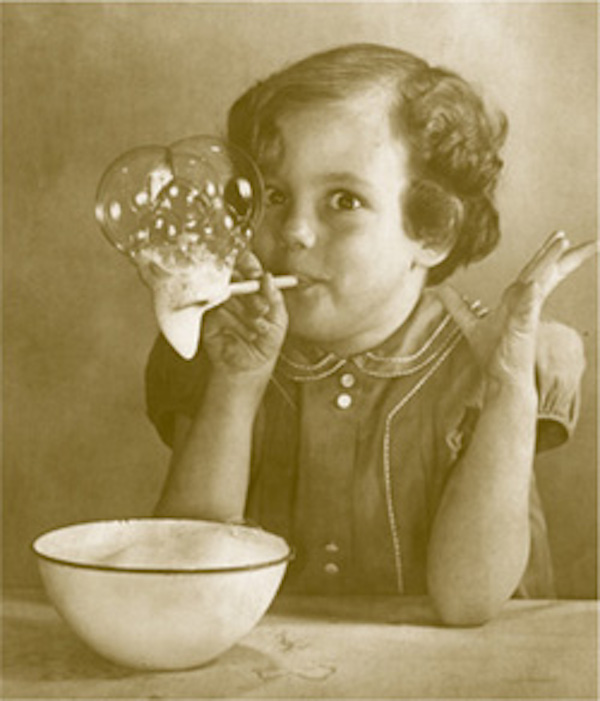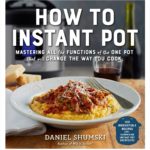Excerpted from Joy Masoff’s Oh, Ick!: 114 Science Experiments Guaranteed to Gross You Out (with Jessica Garrett and Ben Ligon).
Who doesn’t love to blow bubbles? But what makes some bubbles stick around while others pop right away? Let’s see if science can help you make a stronger bubble.

Go Fetch:
- Several bowls
- Masking tape and pen
- Thick liquid dishwashing soap
- Several tablespoons
- Any or all of the following additives:
- corn syrup
- vegetable oil
- gelatin powder
- glycerin (available from a pharmacy)
- sugar
- Several plastic drinking straws
- Timer or clock with a second hand
- Table or countertop that can get wet, or several cookie trays
- Towels for cleaning up
Do This
- Set out several bowls, one for each of the additives you wish to test. Label them with a piece of masking tape and a pen.
- Put 1 tablespoon of liquid dishwashing soap in each bowl.
- Add 1 tablespoon of your chosen additive to its bowl and stir. Leave one bowl for just soap, no additives.
- Add 6 tablespoons of water to each bowl and stir.
- Put a drinking straw in each of the bowls. (Use a different straw for each bowl. If you have friends over, then each person should get his or her own straw so that you don’t swap germs.)
- Dip your hand into one of the bubble mixes and smear a little bit on a table or countertop (if you are allowed) or other flat surface like a cookie tray. Make a separate area for each mixture, about the size of a small dinner plate.
- Lift the straw out of that bubble mixture’s bowl and put it down on the place where you spread its matching bubble mix on the table or tray.
- Gently blow a bubble on the table (it will look like a half bubble because the part on the table is flat).
- If you have friends over, you can each blow a bubble at the same time with different mixes and see which bubble lasts the longest. Or if you are alone, you could blow one bubble and then time how long it takes to burst, then blow another one from a different mix and time that. (Just be sure your bubbles are about the same size.)”
- You can also test which solution allows you to blow the biggest bubbles. When it pops, you can measure the diameter of the damp circle the bubble leaves on the table.
- Save the bubble solutions overnight so you can use it for the next ick-sploration, as well as try these experiments again tomorrow. With the “older” solution, do the bubbles last longer, or can you make bigger ones? (Hint: We think you’ll be surprised.)
What Just Happened?
Okay, first let’s get small. Water is made up of tiny parts called molecules. As you know, water molecules like to hang out together (scientists say they are “attracted”) and so they actually stick to each other. On the surface of a liquid they get really stuck together, and generate a force called surface tension. Think of the molecules as being chained together. If you pull on that chain, you’ll put tension on it. Plain water has high surface tension. But soap lowers the surface tension of water. Remember—soap molecules have a water-loving side and a water-hating side. The soap molecules form a little sandwich around the water. Picture soap as being the bread and the water as being the jelly. The soap forms a thin, flexible “skin” that can stretch when air is blown into it. So the bubble can stretch out, relax, and hang around longer! A bubble will hold together until the water molecules inside the soap “skin” evaporate into the air, or until it touches something dry, like your finger, which rips a hole in the “skin,” a bit like bursting a balloon. Can bubbles say “ouch”?
You probably noticed that the soap and water made a nice bubble—better than just water. But it still didn’t hang out for too long. When you tested the other additives, especially the corn syrup and the glycerin, they made bigger bubbles that lasted longer. That’s because these additives made the bubble stronger by making the soapy liquid thicker. This “thicker skin” keeps the water from evaporating as quickly. Less popping, more oohing and aahing!
To see this ICK-speriment in action, play the video below from The Overstuffed Bookcase (which also features the Homemade Kazoos ICK-tivity).
For even more Ick-tivities, check out the book!





No Comments